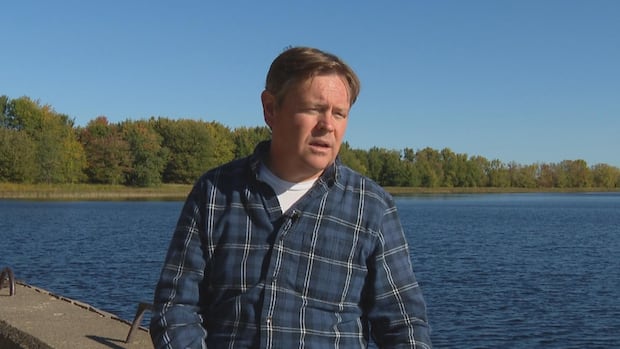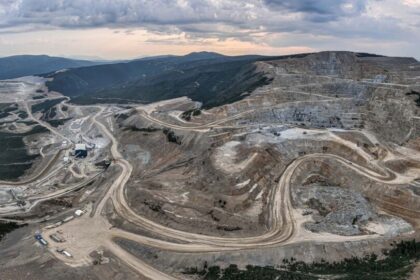New BrunswickEnvironmental scientist Colin Forsythe says water levels in some parts of the province are lower than they were a century ago — and this could be the new normal.Low water levels a product of drought and lack of snow from winter, says scientistIsabelle Leger · CBC News · Posted: Oct 02, 2025 4:17 PM EDT | Last Updated: 43 minutes agoColin Forsythe, environmental scientist and executive director of the St. John River Society, says some water levels in the province are a metre below normal. (Mike Heenan/CBC)A New Brunswick environmental scientist says water levels in some parts of the province are a metre lower than they were a century ago — and this could be the new normal. “It’s very significant,” Colin Forsythe, the executive director of the St. John River Society, told CBC Radio’s Information Morning Fredericton. “It is truly astounding just how low the water levels are. It’s scary.” Forsythe said water levels are low in part because of the historic drought that hit the province this summer, but he said the issue really began last winter. “We didn’t have a really big snow pack, so we didn’t have the usual freshet melt that would recharge groundwater aquifers [and] wetlands, and provide water to the river,” he said.Forsythe has been measuring water levels at historic steamboat wharves along the St. John River. Pictured is the area near Queenstown Wharf in Hampstead Parish. (Mike Heenan/CBC)Forsythe said this level of drought shouldn’t come as a surprise to anyone anymore.”This is exactly what the climate models that we have have been predicting: increased amounts of warm weather, or hot and dry weather, and a lot of climate instability.” WATCH | ‘It’s a big message that says, ‘Hey, our climate here in New Brunswick is drying out’:The St. John River is at an all-time low. Here’s why it’s so worrisome:Water levels of the St. John River — also known as the Wolastoq — have experts concerned as they navigate the impact on the ecosystem. When he was taking water samples at the heritage steamboat wharves along the lower St. John River last week, he found that water levels were at a historic low. And when conducting the watershed’s electrofishing survey, his group found certain areas that could usually be fished but were completely dry. When you can actually see the crib work at some of the steamboat wharves that hasn’t been above the surface of the water in 100 years, that’s a really big red flag…— Colin Forsythe”When you can actually see the crib work at some of the steamboat wharves that hasn’t been above the surface of the water in 100 years, that’s a really big red flag that stuff is not in good shape,” said Forsythe. He said the impacts on some species are significant. Less water and higher air temperatures force water temperatures to rise too.For coldwater fish including salmon and trout, water temperatures above 20 degrees Celsius can be lethal. Warmer water has less dissolved oxygen, “so there’s literally less oxygen for aquatic life to breathe,” said Forsythe. Forsythe said low water levels can have significant impacts on aquatic species, including salmon and trout, by increasing water temperatures, lowering the amount of oxygen in the water, and reducing habitat. (Mike Heenan/CBC)Lower water levels also mean the loss of habitat, and can eliminate spawning beds for some species. The same group of conditions can lower the water’s acidity levels, or pH, and lead to a concentration of bacteria, including E. coli and other types of fecal coliforms.Actions can make a differenceForsythe said solutions are available and start at home. New Brunswickers can reduce their groundwater use by taking shorter showers, avoiding running washing machines several times in one day, and refraining from watering lawns. It is also important to conserve, restore and protect wetlands, Forsythe said: “Those act as sponges and reservoirs for water that re-release it.” Riparian zones, where land meets a body of water, should stay well-vegetated to help keep water temperatures down, he added.Information Morning – Moncton10:42Extremely low water levels in Saint John river causing problems for wildlife, boaters and scientistsColin Forsythe is the executive director of the St. John River Society.”By covering some of those brooks, they reduce evaporation on them, they help with runoff of chemical and nutrient pollutants,” he said. Forsythe said the Environmental Trust Fund has been instrumental in funding important projects for habitat restoration in the province. It was de-funded by the former Progressive Conservation government, and the Holt government has promised to “modernize” it.New Brunswickers can share their input on the importance of that fund by filling our a survey, which is open until Oct. 15. ABOUT THE AUTHORIsabelle Leger is a reporter based in Fredericton. You can reach her at isabelle.leger@cbc.caWith files from Information Morning Fredericton
‘Scary’ low water levels in N.B. are the new normal, says environmental scientist












